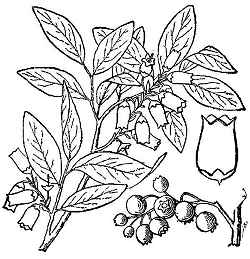
Vaccinium corymbosum, Britton, N.L., and A. Brown. 1913. Illustrated flora of the northern states and Canada. Vol. 2: 700.
Sunset®: 4-6,17
USDA: 3-8
Sun Exposure: Full sun to part shade
Origin: Eastern North America
Growth Habits: Deciduous upright shrub, 5 to 10 feet tall and wide (1.5-3 m); brown, shredding bark, stems with raised dots; simple, elliptical leaves, sometimes with serrated margin, 1 to 2.4 inches long (2.5-6 cm), sometimes slightly pubescent undersides; bright red foliage in the fall
Flowers: White or pink flowers
Watering Needs: Needs moist, acidic soil (pH 4.5 to 5.5), tolerates wet soil
Propagation: Seeds, cuttings
The blueberry bush is a very ornamental bush that also produces an abundance of fruit. Unfortunately its cultivation requirements are pretty exacting.
There are a number of cultivars available.
The species epithet 'corymbosum' refers to the type of inflorescence.
Blooming Habits:
Small, white, bell-shaped flowers, 0.32 inch long (8 mm), in clusters (corymbs), appearing in spring with the leaves.
Fruiting Habits:
Small dark blue to black berries, 0.25 to 0.5 inch (6-12 mm) ripening in mid to late summer.
Desert-Tropicals is dedicated to provide gardening advice, gardening ideas, and information about flower of all kind for landscape and collections.We try to check carefully the identification of the plants on the illustrations as well as the other information from the page, but occasionally errors do occur. if you notice anything that needs to be changed please contact us.Thanks.
© 1998-2020 Philippe Faucon, All Rights Reserved.